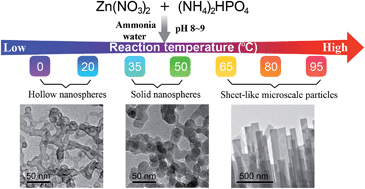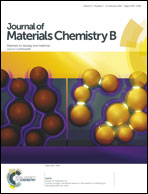Physiochemical properties and bioapplication of nano- and microsized hydroxy zinc phosphate particles modulated by reaction temperature†
Abstract
We investigated the effect of reaction temperature on the particle size and morphology of hydroxy zinc phosphate particles (HZnPPs). The influence of differences in shape on the physiochemical properties of HZnPPs and the possible bioapplications of these particles were also investigated. HZnPPs with both hollow and solid nanospheres and microsized rectangular sheet-like particles were successfully prepared by a wet chemical method using Zn (NO3)2·6H2O and (NH4)2HPO4 as the reactants and ammonia to adjust the pH. The synthesis was performed at temperatures ranging from 0 to 95 °C. The particle size, morphology, crystal structure and thermal properties were analysed by X-ray diffraction, scanning electron microscopy, transmission electron microscopy, the Brunauer–Emmett–Teller specific surface area, thermogravimetric analysis and dynamic light scatting. The chemical composition and vibrational spectra were measured using inductively coupled plasma atomic emission spectrometry, Fourier transform infrared spectrometry and Raman spectrometry. The transmission electron microscopy results showed that a hollow spherical structure with a pore size of 20–30 nm was obtained at reaction temperatures <25 °C. With increasing temperature, the nanoparticles changed from hollow to solid spheres of a similar size. Microsized rectangular sheet-like particles were formed when the reaction temperature was >60 °C. The effect of HZnPPs on cell viability in vitro was evaluated by the MTT assay against normal NIH/3T3 cells. The hollow and solid nanospheres had a lower cell cytotoxicity than the microsized sheet-like particles. Both the nanospheres and the rectangular sheet-like particles were able to adsorb heavy metal ions. The hollow nanospheres were also used as a carrier for a high drug-loading of epirubicin. These results clearly show that temperature plays an important part in regulating the nanoscale hierarchical structure of HZnPPs and their properties.


 Please wait while we load your content...
Please wait while we load your content...